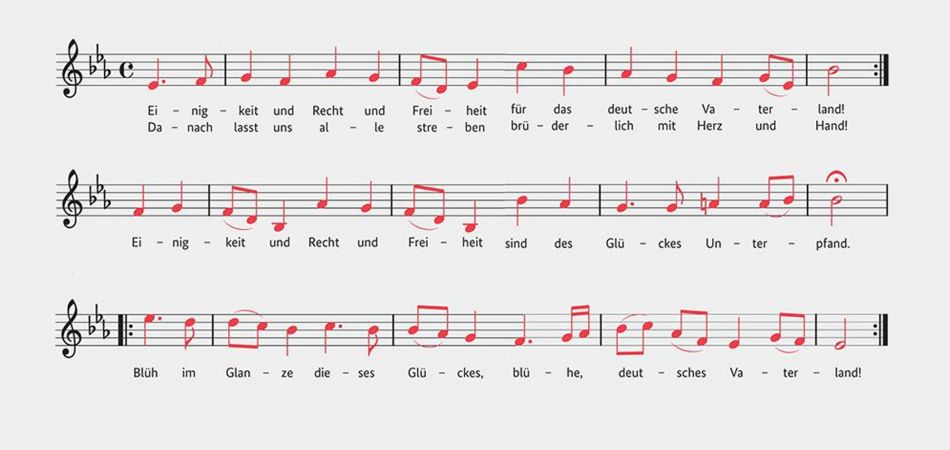Variation noun
The repetition of a musical theme with modifications in such elements as rhythm, melody, harmony, key, tempo, and accompaniment.
https://www.merriam-webster.com/dictionary/variation
Music is like a story. You could always just tell another person, “I got up and went to work and came home around 6,” but that is such a boring story. Similarly, building a piece around the T-PD-D-T structure and leaving it at that becomes monotonous. With so many variables involved in the composition of a piece of music – rhythm, pitch, styles, instrumentation, and more – you can get a lot of mileage out of a simple idea by giving it some thought and varying your approach on the original idea. Abracadabra – you now have a variation! If it were only that simple…
In 1797 Haydn gave to the Austrian nation the stirring song “Gott erhalte Franz den Kaiser” (“God Save Emperor Francis”). It was used for more than a century as the national anthem of the Austrian monarchy and as the patriotic song “Deutschland, Deutschland über alles” (“Germany, Germany Above All Else”) in Germany, where it remains the national anthem as “Deutschlandlied.” The song was so beloved that Haydn decided to use it as a theme for variations in one of his finest string quartets, the Emperor Quartet (Opus 76, No. 3).
https://www.britannica.com/biography/Joseph-Haydn/English-period
Haydn String Quartet No. 62, Op. 76 No. 3 “Emperor” (2nd mov) Veridis Quartet with notes by professorimprov.
Variations can be newly composed works, but they are often built on a recognizable theme and can be classified as sectional or continuous variations.
Sectional Variations
Sectional variations feature themes and variations that are harmonically enclosed and can stand on their own – seasoned trumpet players will automatically think of the themes and variations like the Carnival of Venice in the Arban manuscript. This form was popular in the Classical period.
The Carnival of Venice by Jean Baptiste Arban
Arranged by Donald Hunsberger
United States Navy Concert Band conductor: Capt. Brian Walden
cornet soloist: Musician 1st Class John Armstrong
The folk tune, “The Carnival of Venice,” has become one of the most utilized melodies to demonstrate instrumental virtuosity in a theme and variations-style piece. This was recorded in May of 2015 at the Hylton Performing Arts Center, Manassas, Virginia
https://www.youtube.com/watch?v=Ia6c6uIIb_Q
Continuous Variations
Continuous variations, on the other hand, are ever-changing and use Fortspinnung with themes that are usually shorter than sectional themes. These variations are usually 2 to 8 bars and are often built on a harmonic structure or bass line instead of a melody and accompaniment. This form was popular in the Baroque period – Bach’s Chaconne and Purcell’s “Music for a While” are examples of continuous variations.
Types of Continuous Variations
There are two main types of continuous variation: Ground bass or passacaglia which feature a repeated bass line and upper voice variations, and chaconne which usually features a bass line that is altered typically chromatically or through inversions.
Modes of Variation
There is no singular way to produce a variation, and a variation may be as simple as reducing a piece to a solo voice or as complex as can be. These are just some of the ways that you can change a piece. You can mix and match the descriptions to create your new work or to describe what you are hearing in the work of another composes.
- Character – representative of a certain style or character using musical topics. Portrayals require specific timings, motions, and gestures to accurately depict the character.
- Chromatic – chromaticism that embellishes a line or represents a change in harmony
- Figural – specific embellishment pattern or figure throughout. Often grouped in pairs.
- Polyphonic /Contrapuntal – imitative entries or the employment of independent voices
- Simplifying – reducing a part by lengthening the note durations
- Textural – adding and or removing voices and simplifying or complexifying rhythms
- Timbral – contrasting instrument voices
YouTube Resources
Musical Topics and Thematic Transformation in Final Fantasy – Prof. Richard Anatone, PGCC
This video is a deep dive into musical topics – particularly relating to imagery and symbolism in video game music.
Musical Variations in Practice
This week’s example is based on the folk song, ‘Watermelon is Spoilin’
According to Wikipedia, “Watermelon spoiling on the vine” is a Bahamian folksong, the recording was done by Americans Alan Lomax and Mary Elizabeth Barnicle and sung by a Black Bahamian with a banjo on New Bight, Cat Island, The Bahamas in 1935. The song has also been recorded by “Blind Blake And The Royal Victoria Hotel Calypsos” in 1951 on the album A Group Of Bahamian Songs.”
Here is my take on the folk tale.
Watermelon_is_Spoiling